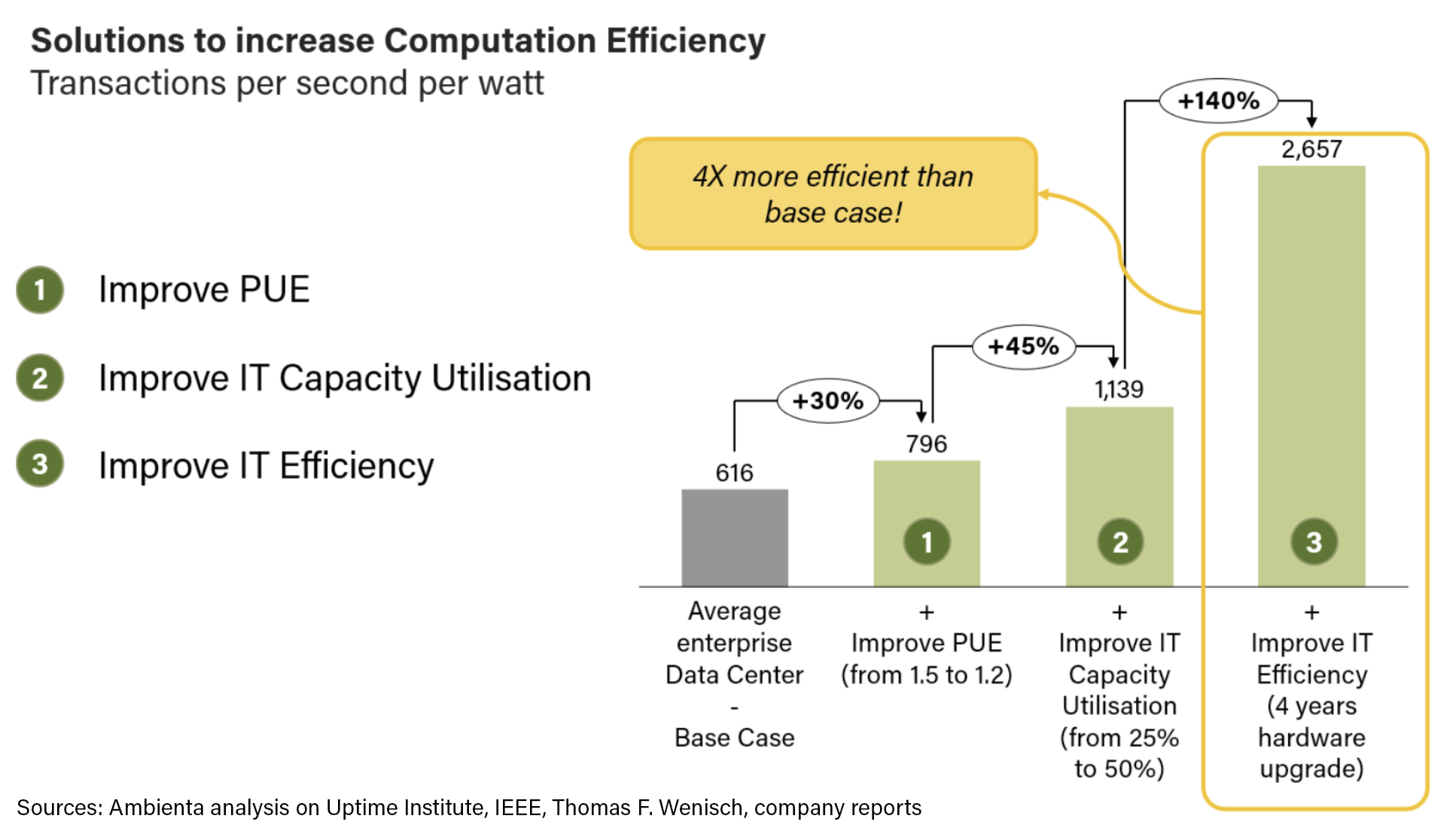Data Centre Computing Efficiency
Environmental Issue
 The ever-present digitalisation trend, together with the recent Gen AI boom, is rapidly pushing the semiconductor industry towards producing increasingly powerful hardware. This surge incomputational capabilities is having a significant impact on data centres, pushing their energy demands to new heights. By 2030, data centres are expected to consume up to 8% of the world’s electricity, a sharp rise from the current 2%. To put this into perspective, data centres in 2030 may require more electricity than the expected global electric car fleet.
The ever-present digitalisation trend, together with the recent Gen AI boom, is rapidly pushing the semiconductor industry towards producing increasingly powerful hardware. This surge incomputational capabilities is having a significant impact on data centres, pushing their energy demands to new heights. By 2030, data centres are expected to consume up to 8% of the world’s electricity, a sharp rise from the current 2%. To put this into perspective, data centres in 2030 may require more electricity than the expected global electric car fleet.
A critical metric for measuring sustainability in data centres is Power Usage Effectiveness (PUE). This indicator assesses the efficiency of a facility’s electricity use, particularly how it powers servers in comparison to other functions like cooling or lighting. Our February 2023 Theme of the Month highlighted the urgent need for sustainable data centre infrastructure, emphasising the increasing importance of Liquid Cooling and Heat Recovery solutions to optimise PUE and effectively utilise the heat generated. However, as data centres approach the theoretical limit of PUE, enhancing infrastructure for further improvements becomes more challenging.
“Enhancing data center sustainability involves more than solely reducing PUE”
An often-underestimated factor in this scenario is the Computation Efficiency. This metric evaluates the amount of work servers can perform per unit of electricity consumed. Enhancing Computation Efficiency could be a game-changer in boosting a data centre’s sustainability performance, potentially having a much greater impact compared to infrastructure modifications alone.
Computing Efficiency involves two main parts:
- IT Capacity Utilisation: refers to how much work the server is actually doing compared to what it could potentially do. Servers usually run at lower capacities (around 20%) to limit the risks of unavailability, but increasing utilisation is key to achieving higher computing efficiency.
- IT Efficiency: refers to how effectively IT equipment, especially processors like CPUs and GPUs, can perform tasks for each watt of power used. This efficiency mainly depends on the type of processors and the hardware provider.
Today, data centre operators are often hesitant to share details about Computing Efficiency as it’s seen as a proprietary business metric. Yet, there is growing interest from customers and regulators, supported by academics and industry experts who highlight the importance of these metrics in understanding the sustainability of data centres.
Solutions
With the recognition of the importance of IT Capacity Utilisation and IT Efficiency shifting into focus, certain software and hardware solutions are beginning to and will continue gaining increasing attention. These are not just vital for sustainability; they also serve as operational tools to cut down on running costs in data centres.
Software plays a crucial role in enhancing IT Capacity Utilisation. Tools such as workload placement and virtualisation software effectively optimises workloads across various machines and adapts to changing workload demands.
In terms of IT Efficiency, the selection and updating of components is critical. The primary focus should be on CPUs, GPUs, and storage, as these are major power consumers in IT equipment. Efficient hardware is emerging, offering more computational power for the same energy consumption. Regular hardware upgrades, ideally every 4-6 years, can significantly improve the efficiency of data centres. It has been calculated that replacing server hardware that is four years old with new models can lead to an average performance improvement of 140%.
“Refreshing IT hardware is the most effective way to increase Computation Efficiency.”

Investment Ideas
Investment strategies should target areas where economic growth and environmental benefits intersect. Companies at the forefront of virtualisation and workload management include VMware (part of Broadcom) and Red Hat (under IBM).
For efficient IT hardware, firms like AMD, Nvidia, ARM, and BE Semiconductor Industries are making significant steps in enhancing the efficiency of the IT equipment.
“Investment strategies should target areas where economic growth and environmental benefits intersect.”
Important information
This material is of a promotional nature and is provided for information purposes only. Please note that this material may contain technical language. For this reason, they may not be suitable for readers without professional investment experience. This document is issued by Ambienta SGR S.p.A. It is not intended for solicitation or for an offer to buy or sell any financial instrument, distribution, publication, or use in any jurisdiction where such solicitation, offer, distribution, publication or use would be unlawful, nor is it aimed at any person or entity to whom it would be unlawful to address such a document. Nothing in this document constitutes legal, accounting or tax advice. The information and analysis contained herein are based on sources considered reliable. Ambienta SGR S.p.A uses its best effort to ensure the timeliness, accuracy, and comprehensiveness of the information contained in this marketing communication. Nevertheless, all information and opinions as well as calculations indicated herein may change without notice.
Ambienta SGR S.p.A. has not considered the suitability of this investment against your individual needs and risk tolerance. To ensure you understand whether our product is suitable, please read the Prospectus and relevant offering documents. Any decision to invest must be based solely on the information contained in the Prospectus and the offering documentation. We strongly recommend that you seek independent professional advice prior to investing
 Luca Zerba Pagella
Luca Zerba Pagella  Fabio Ranghino
Fabio Ranghino 
